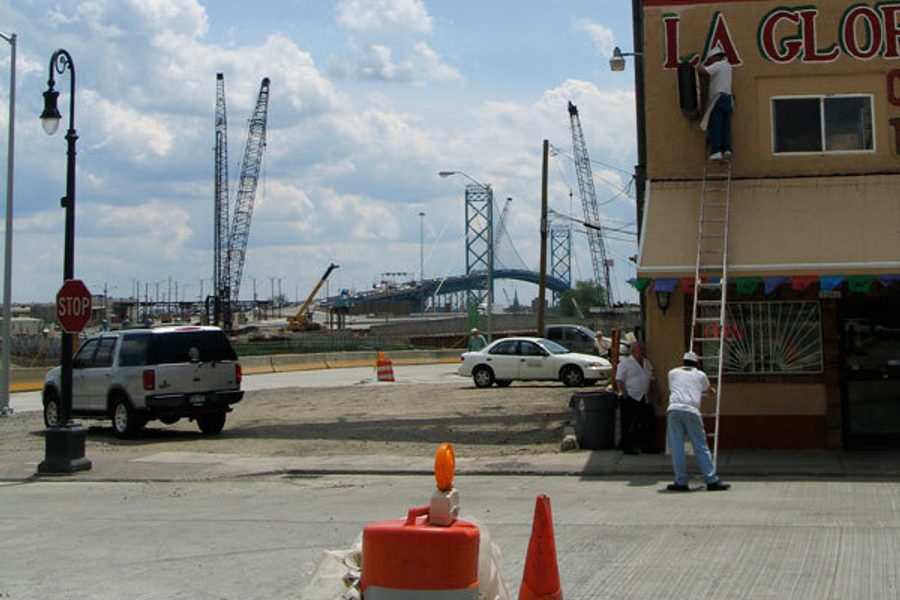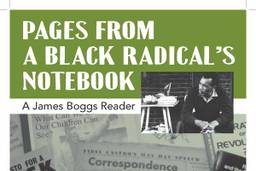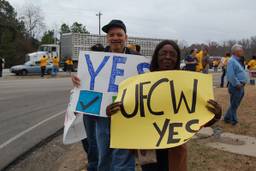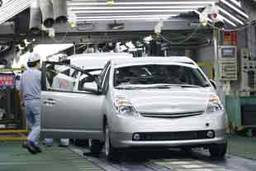Another Detroit is Happening—But Which One Do We Need?
At the U.S. Social Forum, thousands of activists are looking for answers to America’s biggest problems.
Paul Abowd

Tens of thousands of activists have begun arriving for the June 22-26 United States Social Forum. Detroit is hosting the second iteration of a global justice “movement of movements” revival, bringing together nearly every cause on the American left’s radar. But Forum-goers are also focused on the host city at a time when the event’s tagline – “Another Detroit is Happening” – is both promising and foreboding.
Soon after taking office in 2009, Detroit’s new mayor, Dave Bing, assembled his “crisis turnaround team,” a handpicked collection of exiled auto executives, financiers, and PR people. The NBA hall-of-famer and steel executive and his team have acted swiftly to reshape a city they view as a clean slate, a city as vacant as post-Katrina New Orleans.
The new mayor is promising to shrink Detroit and its infrastructure, and has gathered the business community and suburban philanthropies to put downpayments on a dreamscape: a downtown light rail line, a new hockey stadium, shiny charter schools to complement a slimmed down “traditional” district, an industrial farm on the East side, and new housing enclaves.
While the corporate class contemplates new investments, the community has been reminding Bing that Detroit is no empty city. “I think we need to use the Social Forum as an opportunity to say to city officials, look - you’re dealing with a population that can mobilize 20,000 people to come to Detroit,” says Lottie Spady, a food justice organizer working on the Forum. “Outside of a sporting event, when does that happen?”
Visions of Detroit consistently refer to a sparkling time of industry, shopping, and peace that never really existed. The Motor City’s avenues hosted an eight-lane American dream cruise. And when it picked a freeway and left town, the city’s persistent class warfare and racial segregation came into stark relief. Shea Howell says Bing envisions a city that would paper over the city’s long-standing inequality, not confront it.
“Their focal point is creating these protected enclaves with good schools, good services, safety; all those nice things that everybody wants. Only some people will be able to have them, and the rest of us will be on the outside looking in,” says Howell, a teacher, activist and columnist helping to organize the Forum.
City planning documents bemoan city workers and their “large number of labor unions restricting management’s ability to properly control and discipline the workforce.” Bing has demanded 10 percent wage cuts and an end to defined-benefit pensions for the next generation of public employees. Bing is also moving to discontinue the Public Lighting Department and sell operations to DTE Energy, a company notorious for a string of fatal electricity shutoffs in the city.
Today, much of what’s left of the proud auto worker corps is either making close to non-union wages, working non-union jobs, or out of work altogether. A four-month strike by workers at GM-supplier American Axle in 2008 was the rank-and-file’s last big stand before the Big 3’s government-guided implosion. Axle CEO Dick Dauch cut starting wages in half. Months later, he picked up and moved the whole operation to Mexico. Two stadiums, three casinos, and two medical centers have struggled to fill the gaps, leaving thirty percent of residents without a job. That’s the official tally.
Reinvestment and plans to shrink the city might be needed, says Bill Wylie-Kellerman, an organizer of the Forum’s Spirituality Committee. “But how do you do it in a way that isn’t high-handed, that doesn’t write off people’s lives and communities?” asks Wylie-Kellerman, a pastor at St. Peter’s Episcopal. “How do we create democratic involvement in the process of envisioning the new city?”
Organizers are in town for the five-day Social Forum – which offers a series of workshops, meetings, and action-oriented “People’s Movement Assemblies” – to tackle these questions. Some visitors are pasting revolutionary literature on telephone poles, others are jimmying the lights in burned-out apartments. Tent cities on empty lots and in parks are filling up. Forum-goers will see that Detroit showcases not only capitalism’s brutality, but also a community’s resolve to face it. “For a very long time, there’s been an underground, more sustainable version of work being done that has come about out of necessity,” says Spady.
That necessary work precedes the Forum, and will continue when it’s over. Organizers agree, though, that the June gathering is a golden opportunity to solidify alternative visions of the city at a moment when Bing and company are advancing a very different idea about how Detroit’s schools, housing, and empty land should be leveraged, and to whose benefit.
Schoolhouse rocked
State-appointed schools manager Robert Bobb has run up against a legal challenge and neighborhood resistance to his plan to shutter 45 district schools next year. He’s stood shoulder-to-shoulder with a foundation-funded plan to “replace, not reform” the public schools by opening 70 new charter schools by 2020 and handing control to Mayor Bing much sooner.
After a student walkout, teachers and alumni of Northwestern High vowed to sit down, chain the doors, and pursue injunctions – whatever was necessary – to keep the historic school open. Bobb kept 18 schools open, including Northwestern, but vowed to shutter 45 schools by 2013 anyway – if a judge allows him to. Many remaining district schools, some put under private management, will function as magnet schools, taking select applicants, not all comers. District schools will adopt the model of their non-union, charter school counterparts, skimming the best and brightest to raise test scores while pushing communities of “low-performing” students further to the margins.
Ismael Duran Galfano and Mary Duran say they won’t go along with Bobb’s plan for a K-14 “megacampus” that would consolidate three neighborhood schools into one contiguous campus. Bobb asked the long-time residents in the growing Latino neighborhood of Southwest Detroit for some real estate, namely their home, which has been in Mary’s family since it was built in 1910. Galfano runs a community arts center and Duran is retiring this year from 30 years of teaching in the Detroit Public schools. The two have lived in their home and tended their garden there for three decades. Ismael says he didn’t leave Pinochet’s Chile to put up with more dictatorship in his backyard. By email, he told his neighbors he wouldn’t be going without a fight.
“Bobb had no idea this guy’s a community organizer – he’s going to know a thing or two about creating resistance,” says Howell. “I think if they asked people to sit in on their property, they’d have a lot of us right there.”
Bobb eventually got the message, assuring the Duran family and their neighbors that no homes would be destroyed in the consolidation that would bring six-year-olds onto campus with 19-year-olds. The proposal is questionable, and has become the next focus of organizing in the neighborhood.
World’s biggest urban farm?
Bing says he’ll demolish 10,000 homes during his term to ready for rightsizing. But even the mayor has switched up his plans, firing a city planner after her proposal to consolidate two East Side neighborhoods hit the press to bad reviews. The phrase “eminent domain,” loaded in Detroit’s mind after a GM plant wiped out a Polish enclave in 1981, dropped from Bing’s vocabulary. His May invite-only land use summit assembled foundations, investors, and city planners, then promptly went underground, promising to return in 18 months with more details.
Organizers for the USSF aren’t twiddling their thumbs waiting for his re-emergence. Spady’s East Michigan Environmental Action Council organizes around air quality and food justice, engaging Detroit youth with participatory environmental education programs that emphasize media making and civic action. EMEAC has linked with organizations nationwide, hatching plans for a direct action against the city’s trash incinerator. They’re also hosting a youth-led film screening with media-based environmental justice groups like the Green Guerillas and Outta Your Backpack Media.
EMEAC was part of a collaborative effort to establish a Community Food Justice Task Force to examine the entire food system and evaluate where the community can take ownership to meet its needs, not market needs. While a growing network of city gardens builds long-term toward a self-sustaining food system, a financier has tried to take Detroit’s urban agriculture phenomenon large scale. John Hantz has bought hundreds of acres of land on the East Side for what’s being called the “corporate farm,” a year-round operation producing for wholesale markets. But it’s far from a done deal. “When people like Hantz want to come in and plunk down, we’re going to have an educated citizenry to say no no no, this is not what we need,” says Spady.
Between us and homelessness
A 2010 land study shows that 95 percent of Detroit’s vacant single-family homes are still in liveable condition – that’s 218,000 homes suitable for occupancy right now. Still, Detroit’s homeless population is among the highest in the country, and has been on a steady rise. Two major housing projects near downtown have been torn down or vacated in the last decade, their former tenants re-assigned to mixed-income townhouses or displaced in the shuffle. Ballparks and casinos now sit nearby.
Maureen Taylor, a Forum organizer and activist with Michigan Welfare Rights Organization, says the recently demolished East Jeffries projects were not only communities, but solid, well built housing stock. MWRO fights for residents’ basic needs. Their housing takeovers are featured in “Locusts,” a hip-hop documentary by Detroit’s own Invincible and Finale. The video jumps around Detroit to show how space remains contested and cordoned off, even in a city with so much of it.
“We have people who need housing, and we have available housing. So we got those people ready, and took them straight to those units, kicked in the door, got new locks on ‘em,” says Taylor, in “Locusts.” “That’s direct action – there’s nothing else left between us and homelessness.”
Fresh off a month of action that featured civil disobedience “live-ins” at government-owned or foreclosed homes in ten cities, Miami-based Take Back the Land is in Detroit, joining efforts with MWRO and housing rights groups from Chicago and New Orleans at several strategy sessions.
Midtown, USA
Detroit’s Midtown area, a constellation of six central-city neighborhoods, is one of the clearest signs that reinvestment is more than a boardroom daydream. The area bordered by four freeways boasts nearly $2 billion in investment in the last decade. Midtown reaches south to a stunning downtown skyline, still blinking like a real corporate city. Downtown’s entertainment district reaches back to meet it. In between sits the “South Cass” Corridor, a collection of hand-painted signs on bygone bars, plywood, and parking lots – as well as several social service and homeless organizations.
Midtown’s “changing” neighborhood is rebuilding from the ground up, giving rise to a small business bohemia. Gentrification is not an issue now, and it might never be, says Sue Mosey. A long time Detroiter, Mosey heads up the University Cultural Center Association, a non-profit headed up by local business owners and redevelopers. UCCA has its hand in nearly all things Midtown, an idea more than a neighborhood radiating from the Wayne State University campus.
Mosey lists off in rapid fire the projects that her nonprofit has underway. With a $5 million annual budget raised from local foundations, the group funds small business start-ups and facade improvement, street beautification and urban gardens, and is planning an arts district based around an auto dealership turned contemporary art museum.
Then there’s real estate. UCCA owns, manages, and helps develop housing for a mix of incomes – for now. “We haven’t seen anything like other markets where people throw out low-income and go for lucrative high-end,” says Mosey. “That’s not the market here, and that’s not what we’re going for.” All of the UCCA’s projects, she says, have taken place in vacant or abandoned buildings, and many have a green ethos.
While the Midtown name imports its status from New York, the Cass Corridor is undeniably Detroit. The Corridor’s legacy as home to a gritty arts community is too famous to be erased. But its authenticity is becoming marketable, too. “We’re not about changing neighborhood names,” says Mosey. “But we are about branding the bigger neighborhood that encompasses them all, and we call that Midtown.” But slapping a brand on neighborhoods raises the question: can development be about more than just attracting new consumers?
“A little gentrification’s good,” says Pat Dorn with a smile. But it was his concern that the whole neighborhood would go high-end that got Dorn into affordable housing work. The neighborhood was home to a sizeable white, Appalachian auto worker community when he started the Cass Corridor Neighborhood Development Corporation in 1982. Two blocks of Brainard Street in the heart of the Corridor used to house thousands of people, but began clearing out when the Big 3 stopped hiring.
When CCNDC bought up the block for redevelopment, it was a stretch of empty lots and rubble. “We wanted to establish a percentage that would always remain affordable,” says Dorn. “So we took the center, and we dedicated some units to people who get pushed out. “
A developing story
Midtown and the Corridor tout a growing number of community-based projects. A locally-owned organic bakery and health food store share a block. Around the corner, there’s a neighborhood bike shop. Down Cass Avenue, across from the Mandarin signposts of old Chinatown, a recently closed school hosts an independent movie theater and studio space for artists and activists.
While another layer of life and culture imprints itself on the city’s rapidly changing palimpsest – a blend of decay and rebirth, exodus and return – Midtown’s humble, village-like charm exists precariously. Because Detroit has gone from majority white to majority black, from industrial powerhouse to industrial graveyard, in a relatively short period of time, no degree of transformation seems untenable. The covered wagon and the kibbutz set off larger processes of settlement and takeover, and gentrification, too, happens in phases on the urban frontier. Larger commercial and real estate forces always hover, ready to capitalize on “cool,” capable of enacting large-scale transformations in short periods of time.
For now, there’s only one Starbucks in Midtown. And the high-end lofts that sit above it are half-empty. Around the corner, California investors took out a $2 million mortgage on the Hotel Eddystone. The purchase of the 13-story blown-out structure comes after rumors that Detroit Red Wings owner Mike Illitch is considering the Corridor site for a new hockey stadium. A shredded “Move in Now” banner still hangs on the Eddystone’s windowless shell, a reminder of a highly-touted 2005 redevelopment effort - one of many false starts that precede the current attempt to transform one of the poorest parts of the city.
Bing’s remapping efforts will continue to bump up against pervasive inequality in the city. The most transient visitor, funneled from highway off-ramp to casino parking garage, will still see people posted up on every corner, asking for change.
The tens of thousands of visitors arriving in Detroit for the five-day Forum will take on superficial “renewal” plans with skill-building, strategy sessions, and direct action to shape community-driven solutions. They come together, however, with an understanding that no number of visitors can save the city in one week. “It can’t be the end,” says Spady. “We’ll have to come back out from it stronger. It’s got to be more of a beginning.”
A version of this article originally appeared at Truthout.org








